Bees
by Stephen L. Buchmann
Bees comprise a highly diverse group of hymenopterous insects in the Sonoran Desert region. Superficially, bees (especially the parasitic cuckoo bees) resemble some wasps, except that bees are usually hairier and more robust, and they possess specialized structures for carrying pollen back to their nests. Together with ants, bees and wasps form a natural group referred to by taxonomists as the aculeate, or “stinging,” hymenoptera; the stinger is called an aculeus. Only females sting, since the aculeus evolved from the ovipositor or egg-laying tube. Sonoran Desert bees range in size from the world’s smallest bee, Perdita minima, which is less than .08 inches (2 mm) to carpenter bees (the genus Xylocopa), gentle giants that may have body lengths of almost 1½ inches (40 mm) and weigh over a gram. Our native bees burrow into the ground or create nests inside hollow, pithy, dried stems or abandoned tunnels left by wood-boring beetles. All bees are herbivorous except for parasitic forms that prey on other bees.
Herbivorous bees feed on pollen, nectar, and oils offered as floral rewards by flowering plants. Most bees have solitary lifestyles in which females act alone to construct and provision nests, but there are also social forms, such as the familiar black and yellow bumblebees.
Order: Hymenoptera
Families:
Andrenidae, Apidae (includes former Anthophoridae), Colletidae, Halictidae, Megachiliade, Melittidae, Oxaeidae
Sonoran Desert genera:
Agapostemon, Andrena, Anthidium, Anthophora, Ashmeadiella, Bombus, Centris, Coelioxys, Colletes, Diadasia, Epeolus, Exomalopsis, Halictus, Heteranthidium, Hylaeus, Megachile, Melecta, Melissodes, Nomadopsis, Nomia, Osmia, Panurginus, Peponapis, Perdita, Psithyrus, Sphecodes, Stelis, Svastra, Tetralonia, Triepeolus, Xenoglossa, Xenoglossodes, Xeromelecta, Xylocopa
Spanish names:
abeja (bee), jicote, abejorro (bumblebee, carpenter bee)
Distribution
There are at least 45 genera in 7 families, and perhaps as many as 1000 species of bees distributed within the Sonoran Desert bioregion. Unlike most other groups of organisms, bees are most abundant in numbers of both species and individuals in deserts and savannahs, rather than in lowland rainforests. The region around Tucson, Arizona is thought to host more kinds of bees than anywhere else in the world, with the possible exception of some deserts in Israel. In the United States, there are about 5000 species of bees. On a global scale, there are approximately 25,000 named species, but it is likely that as many as 40,000 different species exist.
Ecology
Bees, a highly successful group derived from wasps, live in almost all terrestrial habitats within our region. Except for the parasitic cuckoo bees, all female bees make their living by foraging in search of protein-rich pollen and sugary nectar from flowering plants. By moving pollen around from flower to flower and plant to plant, bees perform vital and often unappreciated roles as the most important group of pollinating animals on earth. Yet bees are not out to “help” flowers; they collect pollen and nectar in order to feed themselves and their larvae.
Of the approximately 640 flowering plant taxa growing in the Tucson Mountains near the Desert Museum, approximately 80 percent of these species have flowers adapted for and pollinated by bees. Similarly, at least 30 percent of our agricultural crops require bees to move pollen between flowers. Not only are we dependent upon these “forgotten pollinators” for over a third of our food, but for other products as well. Cotton cloth is a product that eventually results from bee pollination, and so are many beverages and medicines made from other fruits and seeds.
Without the pollination services bees provide, many plants would not produce seed-laden fruits from which the next generation of plants would grow. Without bees, there would be few or no fleshy berries or fruits to sustain birds, mammals, and other wildlife. The tunneling activity of bees aerates the soil and allows water from infrequent rains to quickly penetrate and reach plant roots; and bees‘ nitrogen-rich feces fertilize the soil. The bees themselves often provide food for lizards, mammals, birds, insects, spiders, and other arachnids.
In their daily quests bees harvest foodstuffs from flowers for themselves and their larvae. Pollen is a rich food source of amino acids, proteins, fatty acids, vitamins, minerals, and carbohydrates. Nectar provides the energy boost from sugars that bees need to fly. Some desert bees (Centris) have specialized scrapers on their legs for harvesting oils from glands on the undersides of specialized flowers in the ratany and malpighia families. These energy-rich oils are are mixed with pollen as larval food and are also used to help construct brood cells. Other bees collect small pebbles, plant hairs, or floral resins that they use as building materials. Some bees, such as mason bees in the genus Osmia, also require water and mud with which to construct their adobe-like nests. Leafcutter bees (Megachile) remove circular pieces of leaves to fashion into cell walls.
Life History

Carpenter bee
The vast majority of desert bees dig burrows in the ground for their brood cells. Cells can be just a few inches deep or six feet or more down in sandy soils. Many species line their burrows or cells with waxy secretions produced by glands within their abdomens. This lining waterproofs the cells, maintains humidity, and keeps organisms like fungi from destroying the food and the developing larvae. Most bees are solitary, that is each female selects a site for her nest, excavates the tunnels, forms and provisions the rounded cells, and lays an egg within each one. This behavior is called “mass provisioning,” since the mother bee collects and prepares at one time all the pollen and nectar food each developing larva will need to complete its life cycle from larval stages to pupa and, finally, through complete metamorphosis into a newly emerged adult. After laying an egg in each cell, the solitary female has no further contact with her progeny. Although solitary, many of our Sonoran Desert bees routinely nest with other females in very large aggregated nest sites. Among them is is our common cactus bee (Diadasia rinconis) which pollinates prickly pear, cholla, and saguaro cacti. Its aggregations during the spring cactus bloom may number in the hundreds of thousands of individual nests over an area the size of 2 to 3 tennis courts.
Other native desert bees don’t go to the bother of excavating their own nests. Instead, they actively search out the abandoned exit holes and tunnels of wood-boring beetles (usually buprestids and cerambycids) in dead limbs or standing dead trees. These bees are known by their common names of leafcutter (the genera Chalicodoma and Megachile) and mason bees (the genus Osmia). Once a beetle burrow is located, these females bring back cut pieces of leaves, resins and pebbles or mud balls with which to fashion cells and their thick, protective capping plugs.
Most of our Sonoran Desert bees have but one generation per year, with adults usually emerging with the spring or summer wildflower blooms. Some species, however, have 2 or even 3 generations per year. In a typical life history, adult males and females mate soon after emergence from their natal cells. Females construct and provision nests and lay eggs, and the larvae develop rapidly underground. During cooler months the larvae usually stay in a resting condition, or diapause, at either the prepupal or the pharate adult stage (the pupal stage just prior to the final molt to the adult proper) until the following spring or summer when they complete their metamorphoses and emerge as adults.
Social Behavior

Bumble bee
A relatively small number of our desert bees are truly social. Bee sociality indicates that these species’ evolutionary paths have diverged from those of their solitary ancestors. In the case of some sweat bees (the family Halictidae), a queen looks like other females in the colony, though she differs in having highly developed ovaries. She may or may not secrete pheromones that elicit feeding and grooming behavior in her daughters. The queen lays all the eggs within the colony. Sweat bee colonies are usually small, consisting of a few dozen or at most a few hundred individuals.
Highly social bees in our region include the introduced honey bee and the native black and yellow bumblebees in the genus Bombus. Bumblebee colonies are annual in nature, established by an already-inseminated queen who emerges from her winter retreat in spring and finds a suitable mouse nest or other underground cavity in which to nest. The queen is larger than her daughters, and lays all the eggs after she has produced, initially, a small brood of workers. Males and queens are produced late in the season and in the colony cycle. They mate, the males die, and the inseminated queens spend the fall and winter “hibernating” below ground until the next spring.
Farther south in Sonora, Mexico (near Alamos), extremely social bees live in colonies with many thousands of individuals — the so-called “stingless bees,” in the genera Melipona and Trigona. These queens are physogastric, with abdomens swollen full of eggs. They are not able to fly once they begin laying eggs, and never leave the colony again. Thus, these social bees represent a still greater caste differentiation between queens and workers. Stingless bees store as much as several quarts (liters) of honey in waxen storage pots that look like clusters of grapes. Indigenous peoples who find these nests within hollow trees sometimes transport the hives back to their villages, where they tend the bees and routinely harvest their honey and beeswax.
Africanized Bees

The infamous Africanized honey bee closely resembles other North American honey bees — even experts have to examine them closely to tell them apart. Africanized or not, a few foraging honey bees are usually no cause for alarm. The only true danger is encountering an Africanized colony. In such cases stay clear of the colony and contact a beekeeper or pest control company.










